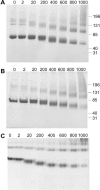Antigenic changes in human albumin caused by reactivity with the occupational allergen diphenylmethane diisocyanate
- PMID: 20123080
- PMCID: PMC3106273
- DOI: 10.1016/j.ab.2010.01.037
Antigenic changes in human albumin caused by reactivity with the occupational allergen diphenylmethane diisocyanate
Abstract
Diphenylmethane diisocyanate (MDI), the chemical commonly used as a cross-linking agent in commercial polyurethane production, is a well-recognized cause of asthma. Reaction products between MDI and "self" proteins are hypothesized to act as antigens capable of inducing airway inflammation and asthma; however, such MDI antigens remain incompletely understood. We used a variety of analytical methods to characterize the range of MDI-albumin reaction products that form under physiological conditions. Sites of MDI conjugation on antigenic MDI-albumin products, as defined by serum immunoglobulin G (IgG) from MDI-exposed workers, were determined by high-performance liquid chromatography (HPLC) followed by tandem mass spectrometry (MS/MS). The data identified 14 MDI conjugation sites (12 lysines and 2 asparagines) on human albumin and highlight reaction specificity for the second lysine in dilysine (KK) motifs, and this may be a common characteristic of "immune-sensitizing" chemicals. Several of the MDI conjugation sites are not conserved in albumin from other species, and this may suggest species differences in epitope specificity for self protein (albumin)-isocyanate conjugates. The study also describes new applications of contemporary proteomic methodology for characterizing and standardizing MDI-albumin conjugates destined for use in clinical research.
Copyright 2010 Elsevier Inc. All rights reserved.
Figures






References
-
- Wisnewski A, Redlich C, Mapp C, Bernstein D. Polyisocyanates. Informa Healthcare; London: 2006.
-
- Redlich CA, Bello D, Wisnewski AV. Health effects of isocyanates. In: Rom WN, editor. Environmental and Occupational Medicine. Lippincott Williams & Wilkins; Philadelphia: 2007. pp. 502–515.
-
- Redlich CA, Bello D, Woskie SR, Streicher RP. Measurements of airborne methylene diphenyl diisocyanate concentration in the US workplace. J. Occup. Environ. Hyg. 2009;6:D82–D83. comment. Author reply, D83–D85. - PubMed
-
- Robert A, Ducos P, Francin JM, Marsan P. Biological monitoring of workers exposed to 4,4′-methylenediphenyl diisocyanate (MDI) in 19 French polyurethane industries. Intl. Arch. Occup. Environ. Health. 2007;80:412–422. - PubMed
-
- Sabbioni G, Wesp H, Lewalter J, Rumler R. Determination of isocyanate biomarkers in construction site workers. Biomarkers. 2007;12:468–483. - PubMed
Publication types
MeSH terms
Substances
Grants and funding
LinkOut - more resources
Full Text Sources
Other Literature Sources

